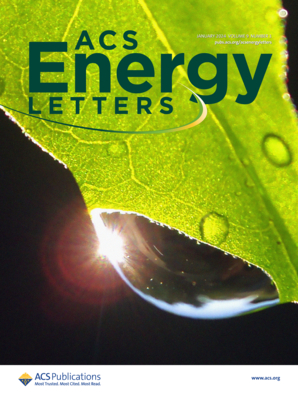Promoting Granular Lithium Sulfide Growth by Soft Acidic–Hard Basic Ionomer Binder for Lithium–Sulfur Batteries
IF 19.3
1区 材料科学
Q1 CHEMISTRY, PHYSICAL
引用次数: 0
Abstract
Electrode passivation limits the reversibility of lithium–sulfur (Li–S) batteries. Pivoting from the prevailing approaches that focus on electrode active materials and electrolytes, herein, we introduce a class of S electrode binders based on soft acidic–hard basic (SAHB) ionomers. The SAHB binder contains a soft cation (tetraallyl ammonium ion, TA+) paired with a hard counteranion (nitrate, NO3–), allowing matched interactions with Li polysulfides (LiPS) via soft acid–soft base (TA+–Sx2–) and hard base–hard acid (NO3––Li+) pairings. This intermolecular coupling retards LiPS diffusion, promoting three-dimensional granular Li sulfide (Li2S) growth, guided by a high Damköhler number (Da). Consequently, the SAHB binder enables a Li–S cell to achieve a high specific capacity of 1545 mAh gsulfur–1 (corresponding to 92.3% S utilization) and stable capacity retention (71.5% after 300 cycles at a current density of 1 C), outperforming previously reported S electrode binders.

求助全文
约1分钟内获得全文
求助全文
来源期刊

ACS Energy Letters
Energy-Renewable Energy, Sustainability and the Environment
CiteScore
31.20
自引率
5.00%
发文量
469
审稿时长
1 months
期刊介绍:
ACS Energy Letters is a monthly journal that publishes papers reporting new scientific advances in energy research. The journal focuses on topics that are of interest to scientists working in the fundamental and applied sciences. Rapid publication is a central criterion for acceptance, and the journal is known for its quick publication times, with an average of 4-6 weeks from submission to web publication in As Soon As Publishable format.
ACS Energy Letters is ranked as the number one journal in the Web of Science Electrochemistry category. It also ranks within the top 10 journals for Physical Chemistry, Energy & Fuels, and Nanoscience & Nanotechnology.
The journal offers several types of articles, including Letters, Energy Express, Perspectives, Reviews, Editorials, Viewpoints and Energy Focus. Additionally, authors have the option to submit videos that summarize or support the information presented in a Perspective or Review article, which can be highlighted on the journal's website. ACS Energy Letters is abstracted and indexed in Chemical Abstracts Service/SciFinder, EBSCO-summon, PubMed, Web of Science, Scopus and Portico.
 求助内容:
求助内容: 应助结果提醒方式:
应助结果提醒方式:


